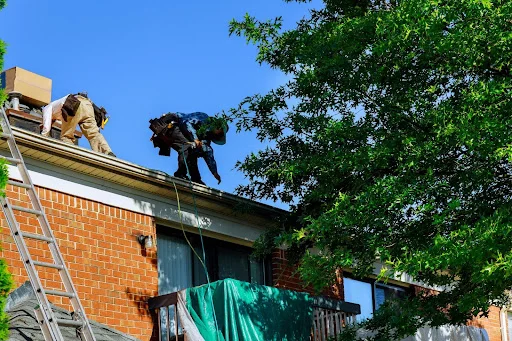A functional roof is pivotal to maintaining the overall health of a home. It acts as the first line of defence against environmental elements, safeguarding everything beneath it. Over time, however, roofs may require replacement; an investment that, while significant, is crucial for preserving home safety and value. This guide provides homeowners with comprehensive knowledge about the roof replacement process from initial inspection to final installation. By understanding what to expect when replacing a roof, homeowners can make informed decisions, balancing the cost against long-term benefits.
Understanding the Necessity of Roof Replacement
Recognising the need for roof replacement is the first step in ensuring home resilience, notes Pocatello property investment strategies company, Five Star. Common indicators that your roof may be nearing the end of its life include persistent leaks, visible sagging, missing shingles, and unusual growths like moss or fungi. While minor issues can often be repaired, extensive damage generally necessitates replacement. So, what’s the difference between repairing and replacing a roof? Repairs are typically suitable for isolated problems, while replacement is recommended when the roof is near the end of its lifespan or has widespread damage.
Age and weather can significantly impact roof durability. Extreme temperatures, heavy rainfall, and strong winds wear down roofing materials over time. In regions with harsher climates, roofs may deteriorate faster, increasing the need for more frequent inspections and replacements.
The benefits of a timely roof replacement extend beyond aesthetics. A new roof enhances property value, ensuring safety and energy efficiency. Potential buyers often seek out homes with new or well-maintained roofs, as it signifies reduced future repair costs and improved insulation capabilities, resulting in lower energy bills.
Stay ahead of trends—click Related Post for insights that spark action today!
How to Conduct a Thorough Roof Inspection
Conducting a thorough roof inspection can help detect issues early, saving time and money in the long run. A DIY inspection begins with a checklist: start by examining interior ceilings and attics for water stains. Then, check the exterior for damaged or missing shingles, sagging gutters, and debris accumulation. Identifying common roof problems, such as leaks or structural damage, can be straightforward when adopting a systematic approach.
For complex roofing issues or when safety is a concern, it’s advisable to call a professional. They possess the training and expertise to spot hidden problems and provide accurate assessments. Moreover, advanced technology and tools such as drones and infrared cameras can enhance inspection accuracy, offering a detailed view of the roof’s condition without the risks associated with climbing ladders.
Selecting the Right Materials for Your New Roof
Choosing the appropriate materials for a new roof involves multiple considerations. Popular options include asphalt shingles, metal, and tile roofing, each with its own merits. Factors to consider when selecting materials include the home’s climate, budget, and desired aesthetic. Energy-efficient and durable materials, while potentially pricier, can lead to significant savings over the roof’s lifetime.
Each roofing material type has distinct pros and cons. Asphalt shingles are cost-effective and versatile, but may not last as long as metal or tile. Metal roofs are durable and eco-friendly, but installation can be costly. Tile roofing provides excellent longevity and classic appeal, though it requires a strong structural framework. By weighing these factors, homeowners can make informed decisions that align with their objectives.
The Step-by-Step Roof Replacement Process
Preparing the home and family for roof replacement work is essential to ensure safety and minimise disruptions. It involves clearing the area around the house, securing outdoor furnishings, and explaining the process to family members.
Professional contractors then begin by removing old roofing materials, carefully disposing of waste to prevent environmental harm. The site is prepared meticulously to ensure a smooth installation process. During installation, experts employ strategic techniques to secure the new roof, ensuring it stands up to weather and time.
After installation, a post-project inspection is crucial. Verifying the quality of workmanship and ensuring all materials are correctly fitted helps avoid potential issues down the line.
Finding and Hiring Professional Roofing Contractors
Finding the right roofing contractor is key to a successful roof replacement. Start by researching and compiling a list of potential candidates. Online reviews and local recommendations can be invaluable in this phase.
When consulting with potential contractors, questions regarding their experience, methods, and timelines can help determine the best fit. It’s essential to check credentials, insurance, and previous customer reviews to gauge their reliability and professionalism.
Understanding contract essentials is another critical element. Homeowners should be clear about warranties, project timelines, and costs before signing an agreement. A meticulously detailed contract protects both parties and ensures a smooth project execution.
Conclusion
Embarking on a roof replacement journey can feel daunting, but a methodical approach simplifies it. By understanding crucial aspects—from identifying the need for replacement to selecting materials and hiring experts—homeowners can achieve lasting results and peace of mind. A commitment to regular maintenance further extends the new roof’s life, maximising investment value. With the right resources and tools at hand, ongoing roof care becomes a manageable part of homeownership, securing a safe and comfortable environment for years to come.
Step beyond the ordinary—Explore More to discover what’s waiting for you at 2A Magazine!







